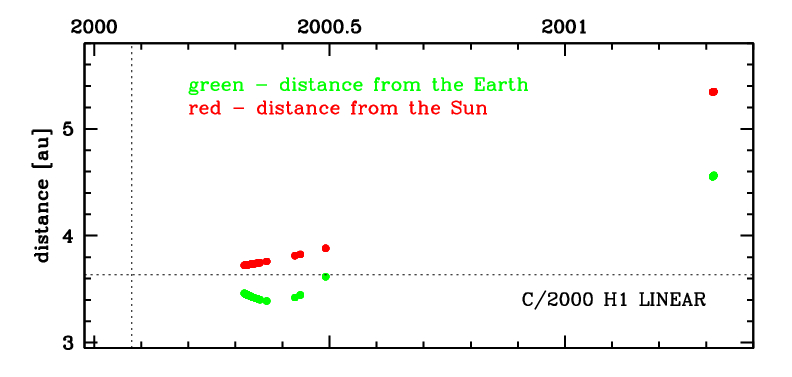C/2000 H1 LINEAR
more info
Comet C/2000 H1 was discovered three months after perihelion passage and next observed up to one year in a range of heliocentric distances from 3.72 au to 5.35 au. However, the observations are unevenly distributed in this period – there is a ten-month gap between 28 June 2000 and 24 April 2001.
Comet had its closest approach to the Earth on 19 May 2000 (3.385 au).
This Oort spike comet suffers moderate planetary perturbations during its passage through the planetary system that lead to a more tight future orbit (see future barycentric orbit).
See also Królikowska and Dybczyński 2017.
Comet had its closest approach to the Earth on 19 May 2000 (3.385 au).
This Oort spike comet suffers moderate planetary perturbations during its passage through the planetary system that lead to a more tight future orbit (see future barycentric orbit).
See also Królikowska and Dybczyński 2017.
| solution description | ||
|---|---|---|
| number of observations | 116 | |
| data interval | 2000 04 26 – 2001 04 25 | |
| data type | observed only after perihelion (POST) | |
| data arc selection | entire data set (STD) | |
| range of heliocentric distances | 3.72 au – 5.35au | |
| detectability of NG effects in the comet's motion | NG effects not determinable | |
| type of model of motion | GR - gravitational orbit | |
| data weighting | YES | |
| number of residuals | 228 | |
| RMS [arcseconds] | 0.60 | |
| orbit quality class | 2a | |
| next orbit statistics, both Galactic and stellar perturbations were taken into account | ||
|---|---|---|
| no. of returning VCs in the swarm | 5001 | * |
| no. of escaping VCs in the swarm | 0 | |
| no. of hyperbolas among escaping VCs in the swarm | 0 | |
| next reciprocal semi-major axis [10-6 au-1] | 220.62 – 269.54 – 319.24 | |
| next perihelion distance [au] | 3.6265 – 3.6313 – 3.6337 | |
| next aphelion distance [103 au] | 6.3 – 7.4 – 9.1 | |
| time interval to next perihelion [Myr] | 0.17 – 0.23 – 0.3 | |
| percentage of VCs with qnext < 10 | 100 | |
| next_g orbit statistics, here only the Galactic tide has been included | ||
|---|---|---|
| no. of returning VCs in the swarm | 5001 | * |
| no. of escaping VCs in the swarm | 0 | |
| no. of hyperbolas among escaping VCs in the swarm | 0 | |
| next reciprocal semi-major axis [10-6 au-1] | 220.62 – 269.54 – 319.24 | |
| next perihelion distance [au] | 3.6303 – 3.6346 – 3.6365 | |
| next aphelion distance [103 au] | 6.3 – 7.4 – 9.1 | |
| time interval to next perihelion [Myr] | 0.17 – 0.23 – 0.3 | |
| percentage of VCs with qnext < 10 | 100 | |
